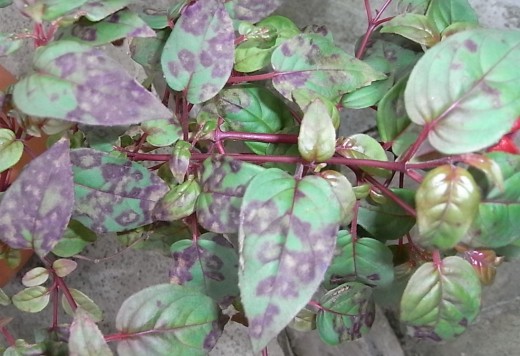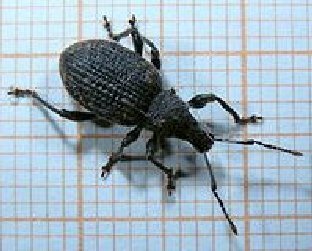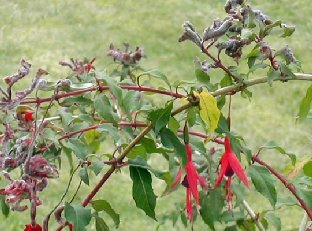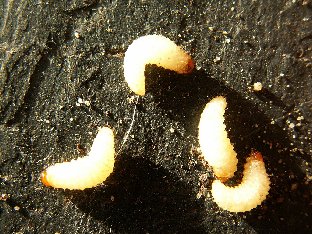BROWN RUST COLOURED AREAS ON LEAVES
The first signs are yellow spots on the top surface of leaves and if you look at the lower surface you will see a fine, dusty, orange coloured area. The orange dust becomes more raised as the disease progresses and may well appear on the top surface as well. The plants looks generally unwell and the leaves begin to fall off. This is most definitely Fuchsia Rust and it is caused by a fungus called Pucciniastrum epilobii.

![]()
Fuchsia rust on underside of leaf
Where the plants are grown in the open it will normally appear from July to September but greenhouse fuchsias can be affected at any time of the year. The disease is is spread when the fungal spots mature and give off spores which spread to other leaves and plants by wind.

![]()
Fuchsia rust on upper surface of leaf
Picture courtesy of reader Maureen Bridge
To treat fuchsia rust pick off any affected leaves on the plant and all leaves which have fallen off naturally, destroy by burning. Rust is often a sign that the plants are not in good condition so ensure they have the correct amount of water. This fungus also thrives on lush green growth so do not feed fuchsias with nitrogen fertilisers, rather use a tomato plant food.
Be very wary of accepting gifts of plants from friends, this is a very common method for the infection to be spread from one garden to another. Quarantine new plants for three weeks if possible, at the very least keep them away from from healthy plants for two or three weeks until you are sure they are clear of infection.
There are no sprays specifically for fuchsia rust but fungicides to cure rose rust can work well. Remember to spray the undersides of leaves as well as the tops. If you want to know more about rust check out our in depth article on allium rust, it is one and the same disease which attacks fuchsias.
LEAF EDGES EATEN, PLANT HEALTH POOR
These are classic signs of the VINE WEEVIL which is one of the plagues of the fuchsia grower both professional and amateur. The vine weevil doesn’t only attack fuchsias, it goes for a wide range of ornamental flowers, fruits and vegetables and it’s becoming more and more common in the UK.
This pest has two stages of life, the adult beetle which eats the edges of leaves and the far more devastating grubs which lurk just below the soil surface and eat the roots.
We have written an in depth article about the wine weevil, how to recognise it and how to treat and we suggest you visit that page here. But before you go there a couple of words of advice especially relevant to fuchsias. This pest loves fuchsia roots and especially so in pots, the open texture of the compost suits its lifestyle ideally.
The eggs are laid from May to September but in greenhouses and heated buildings pot plants can be affected at almost any time of the year. The only way you will notice the damage the grubs do (before your plants keel over and die) is by turning the pots over and inspecting the roots. Look for white healthy root balls and no signs of the grubs as shown in the photo above.
Far better though, and easier, is to keep a check on the leaves from March to August. If there is any damage to the edges of the leaves immediately suspect that the damage has been caused by the adult vine weevil beetle (see picture below) and take action as per our in depth article immediately.

LEAVES DISTORTED, FLOWERING FAILS (FUCHSIA GALL MITE)
These are key symptoms of Fuchsia Gall Mite (Aculops fuchsiae). The foliage near the ends of stems is curled and distorted, some of the leaves have a red or pink tinge to them. The flowers are also distorted and fail to develop properly. The damage is first seen in late May and it will continue to increase in severity through to late September until all the leaves and flowers are a distorted mass. The mites themselves are very small, between 0.2mm and 0.25mm long which makes them almost invisible to the naked eye.

Copyright Fredon Bretagne
Fuchsia Gall Mite originally only affected plants near the South coast of England but as of 2016 / 17 it has now spread north as the map below shows.

It seems likely that within the next ten years it will have spread much further north in the United Kingdom. It is spread through air on wind and through insects moving from an infected plant.
When the pest was first found in the UK in 2007 it was classified by the Food and Environmental Research Agency (FERA) as a notifiable pest, even in private gardens. In 2011 this reporting requirement was lifted although it still remains in force for garden centres and similar commercial businesses.
HOW TO TREAT FUCHSIA GALL MITE
There are manual actions you can take to control Fuchsia Gall Mite although unfortunately there are no nematodes which work against them. The following course of action is recommended:
- The mites are extremely easy to transfer from one plant to another on your hands. If you touch an infected plant wash your hands thoroughly (and any knives etc. used) before doing anything else.
- Clear up all fallen debris around the plant including leaves, stems and flowers. Destroy by burning.
- Cut off all infected growth and destroy by burning. If this means that there is very little left of the plant then it is best to dispose of it completely.
INSECTICIDE SPRAYING SCHEDULE
Originally in 2010 the RHS claimed that that there were no sprays that could be used against Fuchsia Gall Mite by amateur gardeners but they then admitted that they may be wrong. Westland Plant Rescue Bug Killer for Ornamental Plants contains two chemicals, abamectin and thiamethoxam, which do appear to offer some hope for gardeners especially when applied in a specific way. Unfortunately this spray was withdrawn from sale in 2013 with no replacement offered.
It is known that this mite prefers cool conditions and there have been experiments which subjected infected plants to high temperatures to see how this affected the mites. Unfortunately they are only sufficiently affected at temperatures which also kill the plants.
Although they prefer cool conditions, there is some evidence that gall mite do not survive temperatures below 5°C / 41°F for long. This is of course only useful information if you have hardy fuchsias and even so, it is by no means proven.
For those affected by Fuchsia Gall Mite the RHS produced a publication in 2014 which contains the most up to date information. It does not make encouraging reading.
CAPSID BUG
Damage from Capsid Bugs is almost always noticed after the bug has disappeared and started to damage another plants. The flowers will show damage to the edges when they emerge, sometimes with holes in the petals. The leaves are also often attacked and show small holes in them which can be quite extensive. They are most common from May to August.
If you suspect that Capsid Bugs will damage your fuchsias then spray regularly with an insecticide such as Scotts Bug Clear or Doff All-in-One Garden Pest Killer.
LEARN HOW TO CARE FOR FUCHSIAS
CALENDAR |
TAKING CUTTINGS |
PINCHING OUT |
FUCHSIA CARE |
PEST, DISEASE |
STANDARD FUCHSIAS |
OVER-WINTER |
COMMENTS / QUESTIONS LEFT BY OUR READERS
| Date: 26 September 2015 | From: John K. | |
| We have lived close to central London, south of the river for almost 40 years. Our well established garden contains some 25 hardy fuchsias – sadly all but one have a heavy mite infestation. From your excellent article and comments to Clive, as well as the RHS Publication it looks as if Fuchsias may become a thing of the past for us. We will try to save some by cutting down as suggested and leaving them to overwinter undisturbed. | ||
| Date: 23 August 2015 | From: Maureen Bridge | |
| I attach some photos (see above) of the two affected plants. As you can see one in particular has not thrived at all and the other one hasn’t done much although they have both produced flowers, albeit not many. I think the darker one might be rust as I have looked under the leaves and there are gingery patches.
The other one, as you can see, is very sparse and hasn’t grown much. Most leaves have dropped off because of the affliction. The leaves go pale and develop dark green patches which then turn black. Would you suggest burning them rather than trying to revive them as I don’t want it to spread to my healthy crops. ANSWER: It looks like rust to me and if the underside of any leaves have ginger patches on them, it’s conclusive. I would suggest burning them and thoroughly cleaning any pots and the area where the plants are. The spores of rust just spread and spread. I have in the past helped a couple of plants recover from rust because I particularly wanted them. But it involved moving the affected plants to a separate area well away from any other plants which could be affected. I took off the worst affected leaves (and burnt them) then sprayed with a rose fungicide several times over a couple of months. \ Keep the recovering (hopefully) plants slightly underwatered, and definitely under-fed. It is a lot of time and effort and only worth it if you particularly want to save a plant or two. Otherwise get rid of them and buy new ones next year. Good luck. |
||
| Date: 28 July 2015 | From: Clive | |
| I am devastated that it looks like I will lose two plants to fuchsia gall mite. I have had them for 35 years after my dad died. Is there no way of saving them? I live in Soutampton.
ANSWER: It’s really sad to hear that. In all likelihood you will lose the plants but because they are of such sentimental value they are worth some effort to try and save. Here is what I would do, expecting the worst but hoping for the best. I assume they are in the ground given their age, I also assume they are hardy fuchsias? If so, I would cut them down to 2cm above ground level now and burn all the leaves and stems. Dig up the plants and remove all the soil you easily can from the roots. If the roots are too big, trim them to a manageable size. Gently wash the roots and the remaining stem in slightly soapy water by hand. Replant in a container of the appropriate size (just large enough to take the rootball) using good quality compost. Place the containers in the coolest part of the garden you can find. Low light levels caused by shade are not a problem at this stage. Do not feed the plants until mid March next year and try and keep them on the dry side but still slightly moist. The plan is to overwinter them at the coolest temperature you can but not below freezing. If they are left out in the freezing weather for a day or so by accident don’t give up, just move them to a frost free place. Hardy fuchsias can stand a touch of frost but the problem is that you now have the roots in a container and frost can damage them if prolonged. The hope is that this winter in Southampton will be slightly cooler than normal and that temperatures below 5°C / 41°F will occur to kill any remaining fuchsia gall mites on your plants. If at any stage you see leaves emerge keep a very careful watch and remove any which show signs of gall mite infection. Good luck. |
||
| Date: 28 July 2015 | From: Clive | |
| I have suffered a significant infestation of fuchsia gall mite for the first time this season (Chalfont St Giles, Buckinghamshire). Is there any updated advice on a suitable insecticide or treatment that will kill the mites? It certainly seems to be highly contagious between plants.
ANSWER: There are still no insecticides in the UK for this pest as of July 2015. Chalfont St Giles is now in the general area known to have been affected in the UK. The RHS currently report that a rough line from Bishop’s Stortford in the east to Bristol in the west is the northern most spread at the moment. |
||
We have temporarily disabled more questions because we are unable to cope with the workload of answering them at the moment. We are seeking more staff to help with this problem.

Fuchsia Calendar
Taking Cuttings
Pinching Out
Caring for Fuchsias
Pests and Diseases
Growing Standard Fuchsias
Over-winter Tender Fuchsias
PEST & DISEASES OF FUCHSIAS
By David Marks
Before going into detail about the weird and wonderful pests and diseases which can affect fuchsias let us make it very clear that in general they are very healthy plants and unlikely to be affected.
Probably the biggest danger occurs when they are grown in enclosed spaces such as greenhouses. But even there, cleanliness and weekly examination will easily overcome most problems.